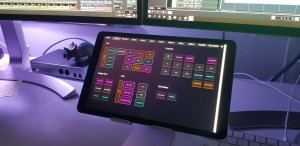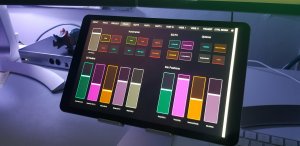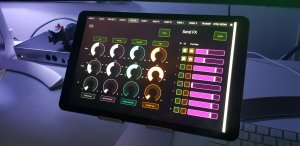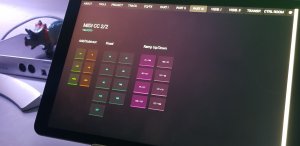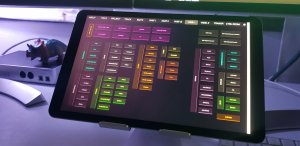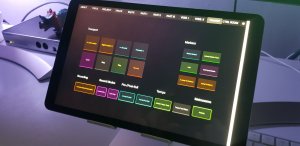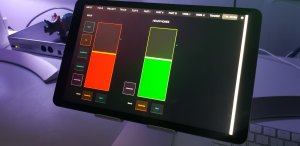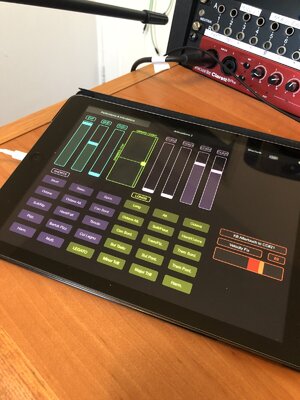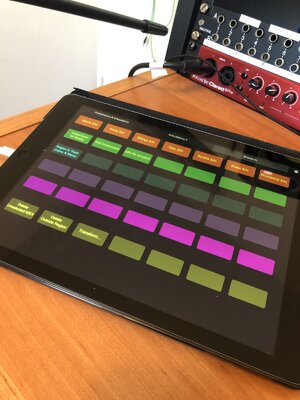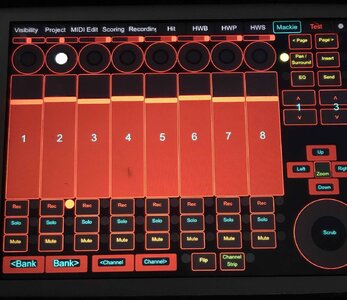Maybe I'm behind the times, but has anyone discovered using TouchOSC as a Mackie controller? I have been playing around with this for the past few weeks and have a screen set up on an old iPad with 8 faders, 8 v-pots, a scrub(?) wheel, bunch of buttons, and LED feedback. (See pic) Using Cubase.
By using a virtual midi cable (such as LoopMidi), I can send the output from Cubase to the cable. Then using MidiTools from Mountain Utilities, I can connect their virtual Mackie screen to the virtual midi cable. Then I use BOME Midi Translator Classic with midi cable as input and TouchOSC as output. I found the translator only needed IF you want the virtual Mackie screen and/or the pan position of Center to show up properly on TouchOSC. If you don't want those, then seems setting midi out to TouchOSC works great also.
I found that the V-pot LED returns seem to be values 17-26 on the appropriate CC. However a value of "Center" is 86. That is why you see the pan position in channels 3-8 appear to be hard right. Channels 1 and 2 are slightly off "C". This picture was taken when I had Cubase's Mackie out connected directly to TouchOSC instead of the virtual midi cable. I use the translator to translate the value of 86 to 22 on those LED's to put the LED in the center.
I can bank and channel left and right and watch the indicators in Cubase move with my button presses. The faders and pan positions also change with the grouping (just like it were motorized faders

). When I touch a fader, Cubase will move the selection to that channel. The faders are set to "Relative" in TouchOSC so I can grab the fader anywhere on the fader and start moving it from its current position without the annoying "jump" in value.
Faders use Pitchwheel for channels 1-8 and set to "Relatvie" to keep a full head of hair. If you want, pitchwheel for channel 9 is set to the Stereo Out control.
V-pots are encoders using value on Channel 1, CC's 16-23 (typically range is 0 to 127 but for the vpots use 65 to 1 to make work properly)
Scrub wheel is encoder using value on channel 1, CC60 (again, range of 65 to 1)
Buttons get a bit trickier. In TouchOSC set them up as "Touch" and "System Exclusive" with a message of 90ii7F where ii is the note ID (Appendix C from
https://web.archive.org/web/20130402181113/https://manuals.info.apple.com/en/Logic7_DedicatedCntrlSurfaceInfo.pdf) (Appendix B is quite helpful also) For Cubase anyway, use https://www.synthmanuals.com/manuals/steinberger/cubase_studio_4/mackie_control_studio/mackie_control_studio.pdf (<span style="color: rgb(84, 172, 210)">https://www.synthmanuals.com/manuals/steinberger/cubase_studio_4/mackie_control_studio/mackie_control_studio.pdf</span>) to convert the Logic control to Cubase control. The ID descriptions in the Logic manual do not necessarily correspond 1 to 1 with Cubase function. In hindsight, you might be able to set buttons using NOTE in TouchOSC but I already started down the sysex path and found it much quicker and easier to set buttons. Also "Local Feedback Off" is checked.
V-Pot pan LED feedback uses the same channel and CC but range is 17 to 27 and convert value 86 to value 22 in BOME.
For button LED feedback set TouchOSC to Value and Note with channel 1, Note ID, and range 0 to 127. Here, Note ID is the ID from the logic document but you need to convert the hexadecimal ID value to decimal to set the Note in TouchOSC. Windows calculator set to Programming mode works great for that or do it manually because math is fun.

Just playing around with BOME's pro trial version, I can see where some pretty powerful stuff could be done.
I'll try to answer any questions, but am certainly no expert. I just found this when I started researching my "rabbit trail" when I asked myself, "What would happen if I...", and it actually started working. Next rabbit trail is, "What will happen if I have TouchOSC set as input to a Mackie AND Generic remote in Cubase?"
Thought and suggestions are welcome.


